Abstract
Open and distance learning system is now well-established serving millions of students globally. The technological developments in the 4th industrial revolution era have impacted open and distance learning system. Artificial intelligence, blockchain, 3D printing, computer vision, internet of things, internet of behaviour etc. have introduced smart services in teaching, learning, curriculum design, learning design, user experience, instructional delivery and evaluation and assessment systems. In this paper we discuss how such technologies have brought the digital transformation to open and distance learning. We also examine the meta immersive smart future of open education.
References
Eden, A. H., Moor, J. H., Søraker, J. H., & Steinhart, E. (2012). Singularity hypotheses: a scientific and philosophical assessment. Springer Berlin Heidelberg Springer e-books Imprint: Springer.
Kurubacak, G., Sisman-Ugur, S., and Sharma, R. (2021). Immersive Smart Open and Distance Learning (SODL) from 6.0 to 7.0. Learning 321, organized by LMP Education Trust, Gurugram, India, August 07, 2021.
Kurzweil, R. (2005). The singularity is near: When humans transcend biology. Viking.
Ugur, S. S., & Kurubacak, G. (2020). Open universities in the future with technological singularity integrated social media. Içinde S. Yu, M. Ally, & A. Tsinakos (Ed.), Emerging Technologies and Pedagogies in the Curriculum (ss. 413-428). Springer Singapore. https://doi.org/10.1007/978-981-15-0618-5_24

This work is licensed under a Creative Commons Attribution-NonCommercial-ShareAlike 4.0 International License.
Copyright (c) 2022 Journal of TAM Academy





